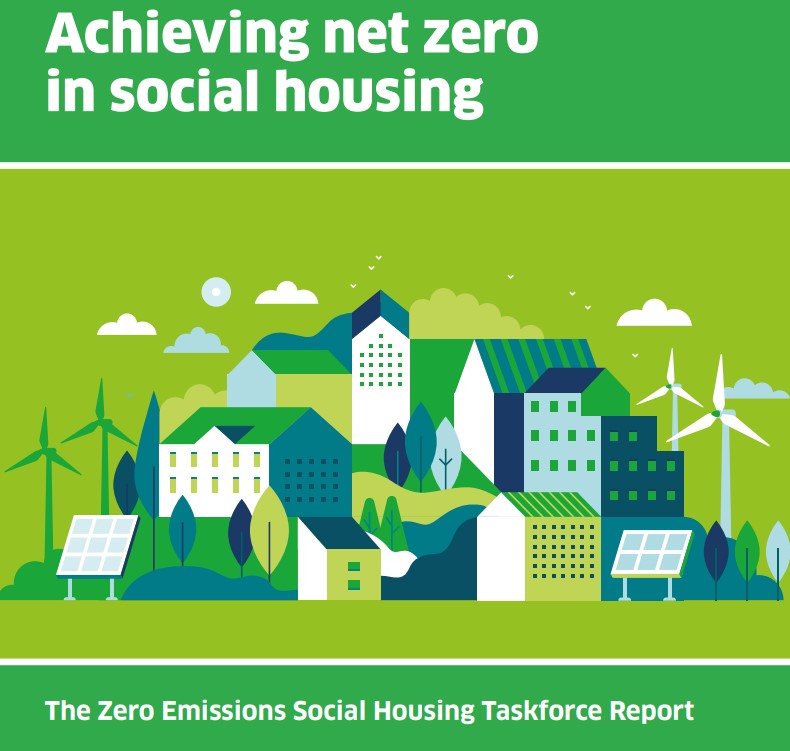Achieving net zero in social housing

|
Contents |
[edit] Introduction
On 31 August 2021, the Scottish Government published Achieving net zero in social housing. This report from the Zero Emissions Social Housing Taskforce (ZEST) included recommendations for what will be required to achieve zero emission housing whilst ensuring support for tenants in reducing their energy bills and achieving carbon savings.
[edit] Eight recommendations
ZEST includes eight recommendations:
- The Scottish Government and social landlords should develop a collective commitment to a just transition in the social housing sector with clear metrics and sufficient budgetary investment to ensure this is successfully realised.
- The Scottish Government should promote a fabric first approach as an essential first step towards decarbonisation, prioritising investment accordingly, and ensure that the promotion of a fabric first approach is reflected appropriately in its review of the Energy Efficiency Standard for Social Housing (EESSH2).
- The Scottish Government should work with social landlords to ensure capital investment for social housing is adequate, structured and designed in line with the needs of the sector, and supports the social housing sector’s aim for a fabric first approach.
- Social landlords and the Scottish Government must work together to plan ahead with certainty, including to work with new partners to access and maximise funding opportunities.
- Social landlords and the Scottish Government should commit to working together in partnership to understand the current condition and investment needs of the existing social housing stock and develop appropriate collaborative solutions.
- Social landlords and both local and national governments should work in partnership to ensure individuals and communities are fully engaged and supported in the net zero transition.
- All partners must work together to ensure there is sufficient workforce capacity in Scotland to deliver high quality retrofit works in the social housing sector.
- Social housing providers should continue to evaluate their wider impacts and ongoing contribution to tackling the climate emergency, through systematic monitoring and measurement.
[edit] Overall net zero housing strategy in Scotland
Achieving net zero in social housing is a follow up to the Scottish Government’s housing standard (published In March 2021) that proposed a legal requirement that all homes must meet the same quality standards. The plan is a component of Housing to 2040, the Government’s 20 year vision for how Scotland’s homes and communities should look and feel in the year 2040.
The ZEST report sits alongside the Scottish Government’s Draft Heat in Buildings Strategy (published in February 2021) as part of the country’s commitment to adapt and retrofit existing homes to improve their energy efficiency and decarbonise their heating. The recommendations in the report highlight the housing sector’s contribution to reducing climate change emissions while decarbonising one million homes by 2030, addressing fuel poverty, keeping rents affordable and promoting equality.
[edit] Related articles on Designing Buildings Wiki
- Fabric first.
- Fabric first investigation into net zero for existing buildings.
- Heat Networks (Scotland) Bill.
- Low carbon building standards strategy for Scotland.
- Net zero carbon 2050.
- Scottish housing standard.
- Scottish planning policy.
- Scotland publishes plans to reach net zero targets with Heat in Buildings Strategy.
- Social housing.
- Zero carbon homes.
[edit] External resources
Featured articles and news
The UK's Modern Industrial Strategy: A 10 year plan
Previous consultation criticism, current key elements and general support with some persisting reservations.
Building Safety Regulator reforms
New roles, new staff and a new fast track service pave the way for a single construction regulator.
Architectural Technologist CPDs and Communications
CIAT CPD… and how you can do it!
Cooling centres and cool spaces
Managing extreme heat in cities by directing the public to places for heat stress relief and water sources.
Winter gardens: A brief history and warm variations
Extending the season with glass in different forms and terms.
Restoring Great Yarmouth's Winter Gardens
Transforming one of the least sustainable constructions imaginable.
Construction Skills Mission Board launch sector drive
Newly formed government and industry collaboration set strategy for recruiting an additional 100,000 construction workers a year.
New Architects Code comes into effect in September 2025
ARB Architects Code of Conduct and Practice available with ongoing consultation regarding guidance.
Welsh Skills Body (Medr) launches ambitious plan
The new skills body brings together funding and regulation of tertiary education and research for the devolved nation.
Paul Gandy FCIOB announced as next CIOB President
Former Tilbury Douglas CEO takes helm.
UK Infrastructure: A 10 Year Strategy. In brief with reactions
With the National Infrastructure and Service Transformation Authority (NISTA).
Ebenezer Howard: inventor of the garden city. Book review.
The Grenfell Tower fire, eight years on
A time to pause and reflect as Dubai tower block fire reported just before anniversary.
Airtightness Topic Guide BSRIA TG 27/2025
Explaining the basics of airtightness, what it is, why it's important, when it's required and how it's carried out.
Construction contract awards hit lowest point of 2025
Plummeting for second consecutive month, intensifying concerns for housing and infrastructure goals.
Understanding Mental Health in the Built Environment 2025
Examining the state of mental health in construction, shedding light on levels of stress, anxiety and depression.
The benefits of engaging with insulation manufacturers
When considering ground floor constructions.
Lighting Industry endorses Blueprint for Electrification
The Lighting Industry Association fully supports the ECA Blueprint as a timely, urgent call to action.























